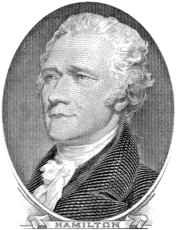|
These are the readings we tended to spend most time on in class, and which carry the main points of the debates we have discussed. All of our discussion forums in Blackboard are still up (and active) to help you review. I.
Mercantilism vs. Markets 3.
Readings on Mercantilism, from Callender (authors' names in footnotes) 4.
Smith, The Wealth of Nations, Bk,
IV, ch. ii, 1776 (1909 ed.), pp. 348-369. II.
Economic Policy and the New Nation 4.
Hamilton's Report on Manufactures, 1791, pp. 192-195, 204-219, 234-244
(Note: Not all pages are included here.) III.
Internal Improvements and Public Land Policy 4.
Henry Clay, 1818, excerpts from Works
of Clay, pp. 133-135. IV.
Tariff Policy 2.
Selections from Callender on the tariff debate 3.
House debate, 1824, from Abridgement of the Debates of Congress, pp.
724-729. 8.
Protection or Free Trade for the
United States of America? 1880 V.
Suffrage 1.
Harriet Martineau, “The Political Non-Existence of Women”, from Society
in America (New York: Saunders & Otley, 1837). 7.
Booker T. Washington, "Atlanta Address", 1895. VI.
Banking and Currency 3.
Selections from MacDonald 4.
Webster's reply to Jackson's veto, Register
of Debates in Congress, 1832, pp. 1221-1230. 5.
Discussion of banks from The Merchant’s Magazine, 1839 as it illustrates a model not unlike
the Federal Reserve System which was adopted 75 years later.
B. The Debate over Currency 8.
William Jennings Bryan speech before the Democratic convention (the
"Cross of Gold" speech), 1896, from The
World's Best Orations, pp. 693-701. VII.
Regulation of Interstate Commerce 2.
C. F. Adams, "The Government and the Railroad Corporations," North
American Review, 1871, pp. 31-61. 3.
Comments in The Nation on
railroads, 1873 4
Wayland & Chapin, Elements of Political Economy, 1886, Ch. XXIV,
"Railway Corporations", pp. 386-395. 5.
The Riddle of the Sphinx, N. Ashby, Chapter 3. VIII.
The Trusts and Antitrust Policy 1.
R. T. Ely, "The Tariff and Trusts--Expenditures for Internal
Improvements," from Shaw, ed., The National Revenues, 1888, pp. 56-67. 2.
Selections from The New York Times,
1887 and 1888. 3.
Andrew Carnegie, "The Bugaboo of Trusts," North
American Review, v. 148, no. 387 (Feb. 1889), pp. 141-150. 4.
Andrew Carnegie, "Wealth," North
American Review, v. 148, no. 391 (June 1889), pp. 653-664. 8.
J. B. Clark, "How to Regulate the Trusts," from Hart, v. IV, pp.
641-644. In
addition to the readings listed above, you should review the various
applications of economics to historical policy problems, including but not
limited to gains from trade (trading corn or wool), supply and demand and
cost curves (especially as applied to tariff problems, agriculture in the
1880s and 90s, and the evolution of trusts), incidence of the burden of a
tax (hats vs. cotton), fractional reserve banking, the workings of a Bank of
Issue (like the Federal Reserve Bank),
the equation of exchange (MV=PY), T-accounts, natural monopoly,
monopoly and monopsony, externalities and public goods, market failure. Another area to consider is the relevance of historical debates to the debates today. Think about how the social and economic principles of political parties have remained constant over the history of the nation, and how they have evolved. These
are all topics which have been discussed in class. You may wish to
consult the powerpoint presentations used in class, and if you have
additional questions, your introductory economics or history textbooks (or
the online equivalents) The
exam will be scheduled for two hours, but I certainly hope it does not take
more than one. The exam will
consist of two parts. The first
part will be a quiz on the last five Trust readings (4-8).
It will be the same format as our other quizzes.
The second part will be several questions designed to test two
things: (a) your understanding of some of the economic concepts covered in
the class, and (b) your understanding of some of the general issues that
have recurred in the different debates.
You will have choices in both parts of the exam. There
will be a review session, TBA. |
![]() TOP
OF PAGE
TOP
OF PAGE
![]() ECO
24 HOME
ECO
24 HOME
![]() DOUG
KLEIN HOME
DOUG
KLEIN HOME
![]() DEPARTMENT
OF ECONOMICS HOME
DEPARTMENT
OF ECONOMICS HOME
![]() UNION
COLLEGE HOME
UNION
COLLEGE HOME
© 2001 J. Douglass Klein
Page created and maintained by J.
Douglass Klein; last modified 03/02/01
.
